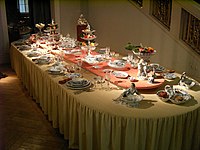A table is a item of furniture comprising a surface supported by a base or legs. It may be used to hold articles such as food at a convenient or comfortable height when sitting, and is therefore often used in conjunction with chairs. Unlike many earlier table designs, most modern tables do not have drawers, although they are not uncommon. A table specifically intended for writing and office work is a desk, which may incorporate one or more drawers in the base. Some tables have removable sections or leaves used to extend the surface, or utilise hinged extensions of the table top known as drop leaves.
Etymology
The term "table" is derived from a merger of French table and Old English tabele, ultimately from the Latin word tabula, "a board, plank, flat piece". In Late Latin, tabula took over the meaning previously reserved to mensa (preserved in Spanish mesa "table"). In Old English, the word replaced bord for this meaning.[1]
[edit] Shape, height, and function

Tables come in a wide variety of shapes, height, and materials, depending on their origin, style, and intended use. All tables are composed of a flat surface and a base with one or more supports, or legs. A table with a single, central foot is a pedestal table. Tables can be freestanding or designed for placement against a wall (a console table). Table tops can be in virtually any shape, although rectangular, square, round (e.g., the round table), and oval tops are the most frequent. Long tables often have extra legs for support. Others have higher surfaces for personal use while either standing or sitting on a tall stool.
Many tables have tops that can be adjusted to change their position or size, either with foldable extensions or sliding parts that can alter the shape of the top. Some tables are entirely foldable for easy transport, e.g., camping. Small tables in trains and aircraft may be fixed or foldable, although many are simply convenient shelves rather than tables.
Types of table

Tables of various shapes and sizes are designed for specific uses:
- A bedside table, nightstand, or night table is a small table used in a bedroom. It is often used for convenient placement of a small lamp, alarm clock, glasses, or other personal items.
- A drawing table usually has a top that can be tilted for making large or technical drawing. It might have a ruler or similar element integrated.
- A gateleg table has one or two hinged leaves that can drop vertically to contract the table surface area.
- A coffee table is a low table designed for use in a living room, in front of a sofa, for convenient placement of drinks, books, or other personal items.
- A chess table is a type of games table that integrates a chessboard.
- A Refectory table is a long table designed to seat many people during dining.(The refectory was the dining hall of a monastery.)
- A Dining room table is any table designed to be dined at.
Historically, various types of tables have been popular for other uses:
- Tripod tables were very popular during the 18th and 19th centuries as candlestands, tea tables, or small dining tables. Their typically round tops often had a tilting mechanism and sometimes rotated as well. The folding top enabled them to be stored out of the way (e.g., in room corners) when not in use.
- Pembroke tables were first introduced during the 18th century and were popular throughout the 19th century. Their main characteristic was a rectangular or oval top with folding or drop leaves on each side. Most examples have one or more drawers and four legs sometimes connected by stretchers. Their design meant they could easily be stored or moved about and conveniently opened for serving tea, dining, writing, or other occasional uses.
- Sofa tables evolved from Pembroke tables and usually have longer and narrower tops. They were specifically designed for placement directly in front of sofas for serving tea, writing, dining, or other convenient uses.
- Work tables were small tables designed to hold sewing materials and implements, providing a convenient work place for women who sewed. They appeared during the 18th century and were popular throughout the 19th century. Most examples have rectangular tops, sometimes with folding leaves, and usually one or more drawers fitted with partitions. Early examples typically have four legs, often standing on casters, while later examples sometimes have turned columns or other forms of support.
- Drum tables are round tables introduced for writing, with drawers around the platform.
- End tables are small tables typically placed beside couches or armchairs. Often lamps will be placed on an end table. May be confused with the lesser known "InTable" which is a fictional type of table.
- Billiards tables are bounded tables on which billiards-type games are played. All provide a flat surface, usually composed of slate and covered with cloth, elevated above the ground.
- Table tennis tables are usually masonite or a similar timber, layered with a smooth low-friction coating. It is divided into two halves by a low net, which separates opposing players

Tidak ada komentar:
Posting Komentar